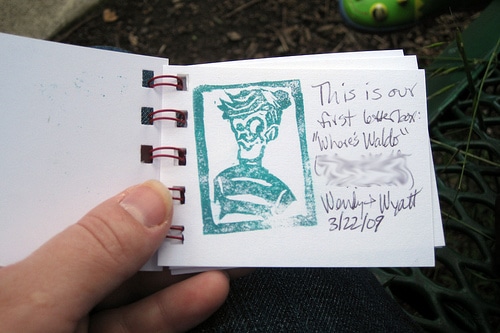
The hitchhiker's stamp should also be recorded in the host letterbox's logbook, and vice versa. When found, it is stamped just like a traditional letterbox, but is then carried by the letterboxer to the next letterbox they find and then left in that letterbox for the next finder. Hitchhiker A traveling letterbox, it is placed in a traditional letterbox for another letterboxer to find. The cuckoo clue typically contains directions to limit how far the clue should travel to find a new home. The clue is hidden in another letterbox (similar to clues for a bonus boxes), but the letterboxer that finds the clue is expected to move the clue to another nearby letterbox. Word of Mouth Box (WOM) The clue is given by word of mouth, or typed up, but a letterboxer can only receive the clue from the planter. Usually planted in the same area as the traditional that hosts its clue. Bonus Box The clues for these are usually found in a traditional box as an extra one to find. Mystery box These are usually traditional boxes, but these "mystery" boxes have either vague starting areas, no starting areas, no descriptions, no clue – any number of things to make the box extremely hard to find. Traditional Box A normal letterbox, hidden and uses clue to find it. While purists recognize only those letterboxes planted in the wild, many new variations exist. There are now many different kinds of letterboxes, each with some specific distinction.

The first gathering in North America was held in November, 1999, at The Inn at Long Trail in Killington, Vermont. Gatherings in the US usually have a special, one-day "Event stamp." At some gatherings, boxes are created or donated to be planted nearby specifically for the gathering attendees to find. Gatherings in the US are usually at parks or places with enough space for a large group of letterboxers to meet up and do exchanges (exchanging of personal stamps and/or personal travelers), as well as talk and discuss box ideas. The first letterbox meet was held on Dartmoor, and they are now held twice yearly on "clock change days" (in March and October). Letterboxers organize events, usually called meets or gatherings. The growing popularity of the somewhat similar activity of geocaching during the 2000s has increased interest in letterboxing as well.Ĭlues to American letterboxes are commonly published on several different websites. Much of the terminology below is associated with letterboxing in the US and would be unfamiliar to UK letterboxers. is generally considered to have started with a feature article in the Smithsonian magazine in April 1998. The Scottish artist Alec Finlay has placed letterboxes with rubber stamp circle poems at locations around the world, including Yorkshire Sculpture Park. Letterboxes can be found in other areas of the United Kingdom including the North York Moors and have spread all over the world. Letterboxing has become a popular sport, with thousands of walkers gathering for 'box-hunts' and while in some areas of Dartmoor it is particularly popular amongst children, some of the more difficult to find boxes and tougher terrain are better suited to more experienced adults.

Some clues may also be found in other letterboxes or on the Internet, but this is more commonly for letterboxes in places other than Dartmoor, where no "100 Club" or catalogue exist. Some letterboxes however remain "word of mouth" and the clues to their location can only be obtained from the person who placed the box.

Clues to the locations of letterboxes are published by the "100 Club" in an annual catalogue. Membership of the "100 Club" is open to anyone who has found at least 100 letterboxes on Dartmoor.

As a result, the tradition of leaving a letter or postcard in the box has been forgotten. Increasingly, however, letterboxes have been located in relatively accessible sites and today there are thousands of letterboxes, many within easy walking distance of the road. Until the 1970s there were no more than a dozen such sites around the moor, usually in the most inaccessible locations. The first Dartmoor letterboxes were so remote and well-hidden that only the most determined walkers would find them, allowing weeks to pass before the letter made its way home. In 1938 a plaque and letterbox in Crossing's memory were placed at Duck's Pool on southern Dartmoor. The next person to discover the site would collect the postcards and post them. From this hikers on the moors began to leave a letter or postcard inside a box along the trail (sometimes addressed to themselves, sometimes a friend or relative)-hence the name "letterboxing". William Crossing in his Guide to Dartmoor states that a well known Dartmoor guide (James Perrott ) placed a bottle for visiting cards at Cranmere Pool on the northern moor in 1854. The origin of letterboxing can be traced to Dartmoor, Devon, England in 1854.


 0 kommentar(er)
0 kommentar(er)
